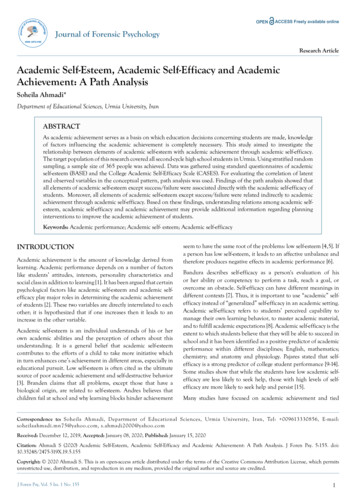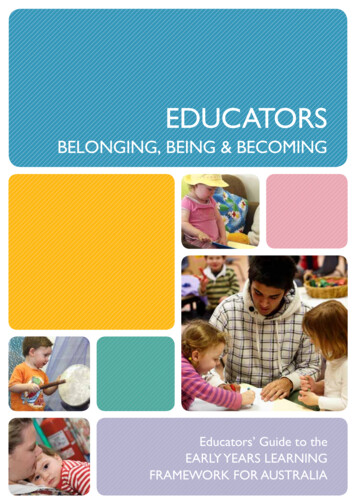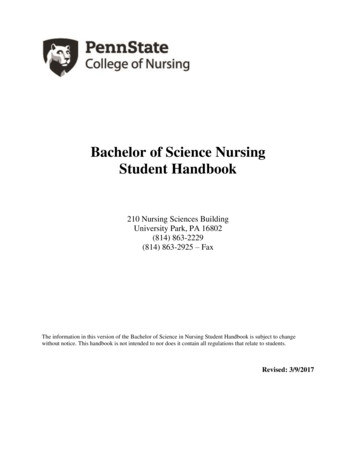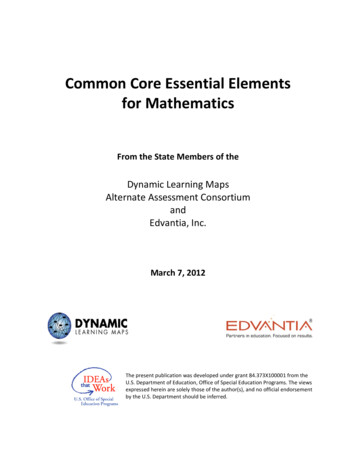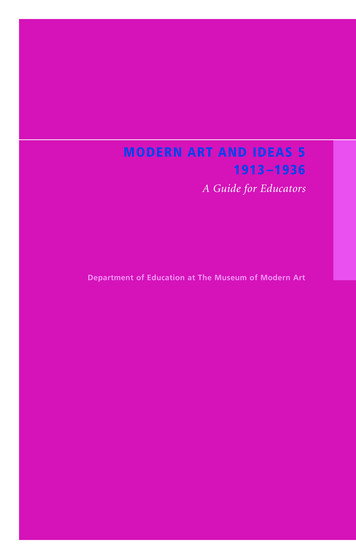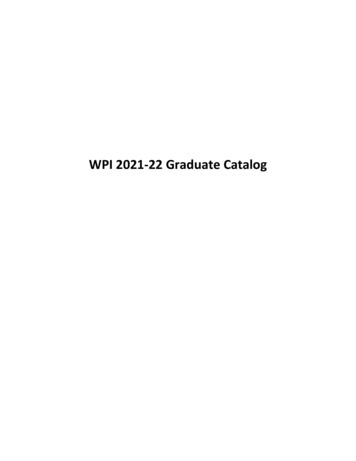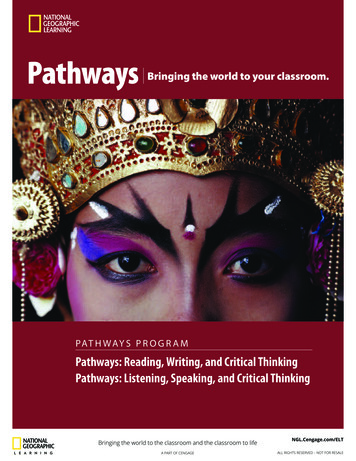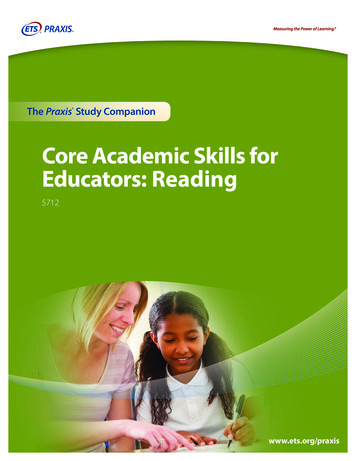
Transcription
The Praxis Study CompanionCore Academic Skills forEducators: Reading5712www.ets.org/praxis
Welcome to the Praxis Study CompanionWelcome to The Praxis Study CompanionPrepare to Show What You KnowYou have been working to acquire the knowledge and skills you need for your teaching career. Now you areready to demonstrate your abilities by taking a Praxis test.Using the Praxis Study Companion is a smart way to prepare for the test so you can do your best on test day.This guide can help keep you on track and make the most efficient use of your study time.The Study Companion contains practical information and helpful tools, including: An overview of the Praxis tests Specific information on the Praxis test you are taking A template study plan Study topics Practice questions and explanations of correct answers Test-taking tips and strategies Frequently asked questions Links to more detailed informationSo where should you start? Begin by reviewing this guide in its entirety and note those sections that you needto revisit. Then you can create your own personalized study plan and schedule based on your individual needsand how much time you have before test day.Keep in mind that study habits are individual. There are many different ways to successfully prepare for yourtest. Some people study better on their own, while others prefer a group dynamic. You may have more energyearly in the day, but another test taker may concentrate better in the evening. So use this guide to develop theapproach that works best for you.Your teaching career begins with preparation. Good luck!Know What to ExpectWhich tests should I take?Each state or agency that uses the Praxis tests sets its own requirements for which test or tests you must take forthe teaching area you wish to pursue.Before you register for a test, confirm your state or agency’s testing requirements at www.ets.org/praxis/states.How are the Praxis tests given?Praxis tests are given on computer. Other formats are available for test takers approved for accommodations (seepage 45).The Praxis Study Companion2
Welcome to the Praxis Study CompanionWhat should I expect when taking the test on computer?When taking the test on computer, you can expect to be asked to provide proper identification at the testcenter. Once admitted, you will be given the opportunity to learn how the computer interface works (how toanswer questions, how to skip questions, how to go back to questions you skipped, etc.) before the testing timebegins. Watch the What to Expect on Test Day video to see what the experience is like.Where and when are the Praxis tests offered?You can select the test center that is most convenient for you. The Praxis tests are administered through aninternational network of test centers, which includes Prometric Testing Centers, some universities, and otherlocations throughout the world.Testing schedules may differ, so see the Praxis web site for more detailed test registration information at www.ets.org/praxis/register.The Praxis Study Companion3
Table of ContentsTable of ContentsThe Praxis Study Companion guides you through the steps to success1. Learn About Your Test.5Learn about the specific test you will be taking2. F amiliarize Yourself with Test Questions.7Become comfortable with the types of questions you’ll find on the Praxis tests3. Practice with Sample Test Questions. 11Answer practice questions and find explanations for correct answers4. Determine Your Strategy for Success. 20Set clear goals and deadlines so your test preparation is focused and efficient5. Develop Your Study Plan. 23Develop a personalized study plan and schedule6. Review Study Topics. 27Review study topics with questions for discussion7. Review Smart Tips for Success. 43Follow test-taking tips developed by experts8. Check on Testing Accommodations. 45See if you qualify for accommodations that may make it easier to take the Praxis test9. Do Your Best on Test Day. 46Get ready for test day so you will be calm and confident10. Understand Your Scores. 48Understand how tests are scored and how to interpret your test scoresAppendix: Other Questions You May Have . 50The Praxis Study Companion4
Step 1: Learn About Your Test1. Learn About Your TestLearn about the specific test you will be takingCore Academic Skills for Educators: Reading (5712)Test at a GlanceTest NameCore Academic Skills for Educators: ReadingTest Code5712Time85 minutesNumber of Questions56 selected-response questionsFormatSelected-response questions based on reading passages and statementsTest DeliveryComputer deliveredContent CategoriesApproximateNumber ofQuestions*ApproximatePercentage ofExaminationI.Key Ideas and Details17–2235%II.Craft, Structure, and Language Skills14–1930%III. Integration of Knowledge and Ideas17–2235%IIIIII* Includes both scored and unscored (pretest) questions. Depending on the number of pretest questionsincluded in each scoring category, the total number of questions in that category may vary from one form ofthe test to another.About This TestThe Core Academic Skills for Educators Test in Reading measures academic skills in reading needed to preparesuccessfully for a career in education. All skills assessed have been identified as needed for college and careerreadiness, in alignment with the Common Core State Standards for Reading. In particular, there is an emphasison skills that are critical to learning and achievement in teacher preparation programs. These skills include theability to understand, analyze, and evaluate texts of different kinds. Varying in difficulty, the reading materialon the test is drawn from a variety of subject areas and real-life situations that educated adults are likely toencounter. Each passage is followed by questions that are based on its content and that relate to reading skills.All questions can be answered by using information contained within the passage; no question requires outsideknowledge of the content.The test consists of four types of stimulus material: paired passages totaling approximately 200 words followedby four to seven questions, long passages of approximately 200 words with four to seven questions, shortpassages of approximately 100 words with two or three questions, and brief statements followed by a singlequestion. Passages are drawn from both print and electronic media, such as newspapers, magazines, journals,nonfiction books, novels, online articles, and visual representations (e.g., diagrams, charts, drawings, maps, floorplans, or graphs). Questions in each of the formats may pose tasks of varying difficulty and test any of the skillsidentified in the Topics Covered section.This test may contain questions that will not count toward your score.The Praxis Study Companion5
Step 1: Learn About Your TestTest SpecificationsTest specifications in this chapter describe theknowledge and skills measured by the test. Study topicsto help you prepare to answer test questions can befound on page 27.I.D.1. Determine whether information presented in areading selection is presented as fact or opinionE.Key Ideas and DetailsA.Read closely to determine what a text says explicitlyand to make logical inferences from it; connectinsights gained from specific details to anunderstanding of the text as a whole; attend toimportant distinctions the author makes and to anygaps or inconsistencies in the account; determinewhere the text leaves matters uncertain1. Draw inferences and implications from thedirectly stated content of a reading selectionB.F.Understand figurative language and nuances inword meaningsG.Understand a range of words and phrases sufficientfor reading at the college and career readiness levelIII.A.II.A.B.B.2. Identify how a reading selection is organized interms of cause/effect, compare/contrast,problem/solution, etc.C.3. Determine the logical assumptions upon whichan argument or conclusion is basedInterpret words and phrases as they are used in atext and recognize how specific word choicesshape meaning or tone1. Identify key transition words and phrases in areading selection and how they are usedIdentify and evaluate the argument and specificclaims in a text, including the validity of thereasoning as well as the relevance and sufficiencyof the evidence2. Determine whether evidence strengthens,weakens, or is relevant to the arguments in areading selectionCraft, Structure, and Language SkillsAnalyze the structure of a text, including howspecific parts of a text relate to each other and tothe whole to contribute to meaningAnalyze content presented in diverse media andformats, including visually and quantitatively, aswell as in words1. Identify the relationship among ideas presentedin a reading selectionIdentify how and why individuals, events, or ideasinteract within a text; determine how an idea ordetail informs an author’s argument1. Determine the author’s attitude toward materialdiscussed in a reading selectionIntegration of Knowledge and Ideas1. Answer questions about texts that include visualrepresentations2. Identify summaries or paraphrases of thesupporting ideas and specific details in a readingselectionC.Determine the meaning of unknown and multiplemeaning words and phrases by using context clues1. Identify the meanings of words as they are usedin the context of a reading selectionDetermine central ideas or themes of a text andanalyze their development; identify accuratesummaries of key supporting details and ideas1. Identify summaries or paraphrases of the mainidea or primary purpose of a reading selectionApply knowledge of language to understand howlanguage functions in different contexts and tocomprehend more fully when reading4. Draw conclusions from material presented in areading selectionC.Analyze how two or more texts address similarthemes or topics in order to build knowledge and/or compare the approaches the authors take1. Recognize or predict ideas or situations that areextensions of or similar to what has beenpresented in a reading selection2. Apply ideas presented in a reading selection toother situationsAssess how point of view or purpose shapes thecontent and style of a text1. Determine the role that an idea, reference, orpiece of information plays in an author’sdiscussion or argumentThe Praxis Study Companion6
Step 2: Familiarize Yourself with Test Questions2. Familiarize Yourself with Test QuestionsBecome comfortable with the types of questions you’ll find on the Praxis testsThe Praxis assessments include a variety of question types: constructed response (for which you write aresponse of your own); selected response, for which you select one or more answers from a list of choices ormake another kind of selection (e.g., by clicking on a sentence in a text or by clicking on part of a graphic); andnumeric entry, for which you enter a numeric value in an answer field. You may be familiar with these questionformats from taking other standardized tests. If not, familiarize yourself with them so you don’t spend timeduring the test figuring out how to answer them.Understanding Computer-Delivered QuestionsQuestions on computer-delivered tests are interactive in the sense that you answer by selecting an optionor entering text on the screen. If you see a format you are not familiar with, read the directions carefully. Thedirections always give clear instructions on how you are expected to respond.For most questions, you respond by clicking an oval to select a single answer from a list of answer choices.However, interactive question types may also ask you to respond by: Clicking more than one oval to select answers from a list of choices. Typing in an entry box. When the answer is a number, you may be asked to enter a numerical answer.Some questions may have more than one place to enter a response. Clicking check boxes. You may be asked to click check boxes instead of an oval when more than onechoice within a set of answers can be selected. Clicking parts of a graphic. In some questions, you will select your answers by clicking on a location (orlocations) on a graphic such as a map or chart, as opposed to choosing your answer from a list. Clicking on sentences. In questions with reading passages, you may be asked to choose your answers byclicking on a sentence (or sentences) within the reading passage. Dragging and dropping answer choices into targets on the screen. You may be asked to select answersfrom a list of choices and drag your answers to the appropriate location in a table, paragraph of text orgraphic. Selecting answer choices from a drop-down menu. You may be asked to choose answers by selectingchoices from a drop-down menu (e.g., to complete a sentence).Remember that with every question you will get clear instructions.Perhaps the best way to understand computer-delivered questions is to view the Computer-delivered TestingDemonstration on the Praxis web site to learn how a computer-delivered test works and see examples ofsome types of questions you may encounter.The Praxis Study Companion7
Step 2: Familiarize Yourself with Test QuestionsUnderstanding Selected-Response QuestionsMany selected-response questions begin with the phrase “which of the following.” Take a look at this example:Which of the following is a flavor made from beans?(A) Strawberry(B) Cherry(C) Vanilla(D) MintHow would you answer this question?All of the answer choices are flavors. Your job is to decide which of the flavors is the one made from beans.Try following these steps to select the correct answer.1) L imit your answer to the choices given. You may know that chocolate and coffee are also flavors madefrom beans, but they are not listed. Rather than thinking of other possible answers, focus only on the choicesgiven (“which of the following”).2) E liminate incorrect answers. You may know that strawberry and cherry flavors are made from fruit andthat mint flavor is made from a plant. That leaves vanilla as the only possible answer.3) V erify your answer. You can substitute “vanilla” for the phrase “which of the following” and turn thequestion into this statement: “Vanilla is a flavor made from beans.” This will help you be sure that your answeris correct. If you’re still uncertain, try substituting the other choices to see if they make sense. You may wantto use this technique as you answer selected-response questions on the practice tests.Try a more challenging exampleThe vanilla bean question is pretty straightforward, but you’ll find that more challenging questions have asimilar structure. For example:Entries in outlines are generally arranged accordingto which of the following relationships of ideas?(A) Literal and inferential(B) Concrete and abstract(C) Linear and recursive(D) Main and subordinateYou’ll notice that this example also contains the phrase “which of the following.” This phrase helps youdetermine that your answer will be a “relationship of ideas” from the choices provided. You are supposed to findthe choice that describes how entries, or ideas, in outlines are related.Sometimes it helps to put the question in your own words. Here, you could paraphrase the question in this way:“How are outlines usually organized?” Since the ideas in outlines usually appear as main ideas and subordinateideas, the answer is (D).The Praxis Study Companion8
Step 2: Familiarize Yourself with Test QuestionsQUICK TIP: Don’t be intimidated by words you may not understand. It might be easy to be thrown by wordslike “recursive” or “inferential.” Read carefully to understand the question and look for an answer that fits. Anoutline is something you are probably familiar with and expect to teach to your students. So slow down, anduse what you know.Watch out for selected-response questions containing “NOT,” “LEAST,” and “EXCEPT”This type of question asks you to select the choice that does not fit. You must be very careful because it is easyto forget that you are selecting the negative. This question type is used in situations in which there are severalgood solutions or ways to approach something, but also a clearly wrong way.How to approach questions about graphs, tables, or reading passagesWhen answering questions about graphs, tables, or reading passages, provide only the information that thequestions ask for. In the case of a map or graph, you might want to read the questions first, and then look at themap or graph. In the case of a long reading passage, you might want to go ahead and read the passage first,noting places you think are important, and then answer the questions. Again, the important thing is to be sureyou answer the questions as they refer to the material presented. So read the questions carefully.How to approach unfamiliar formatsNew question formats are developed from time to time to find new ways of assessing knowledge. Tests mayinclude audio and video components, such as a movie clip or animation, instead of a map or reading passage.Other tests may allow you to zoom in on details in a graphic or picture.Tests may also include interactive questions. These questions take advantage of technology to assessknowledge and skills in ways that standard selected-response questions cannot. If you see a format you arenot familiar with, read the directions carefully. The directions always give clear instructions on how you areexpected to respond.QUICK TIP: Don’t make the questions more difficult than they are. Don’t read for hidden meanings or tricks.There are no trick questions on Praxis tests. They are intended to be serious, straightforward tests ofyour knowledge.Understanding Constructed-Response QuestionsConstructed-response questions require you to demonstrate your knowledge in a subject area by creatingyour own response to particular topics. Essays and short-answer questions are types of constructed-responsequestions.For example, an essay question might present you with a topic and ask you to discuss the extent to which youagree or disagree with the opinion stated. You must support your position with specific reasons and examplesfrom your own experience, observations, or reading.Take a look at a few sample essay topics: “ Celebrities have a tremendous influence on the young, and for that reason, they have a responsibility toact as role models.” “ We are constantly bombarded by advertisements—on television and radio, in newspapers andmagazines, on highway signs, and the sides of buses. They have become too pervasive. It’s time to putlimits on advertising.” “ Advances in computer technology have made the classroom unnecessary, since students and teachersare able to communicate with one another from computer terminals at home or at work.”The Praxis Study Companion9
Step 2: Familiarize Yourself with Test QuestionsKeep these things in mind when you respond to a constructed-response question1) A nswer the question accurately. Analyze what each part of the question is asking you to do. If thequestion asks you to describe or discuss, you should provide more than just a list.2) A nswer the question completely. If a question asks you to do three distinct things in your response,you should cover all three things for the best score. Otherwise, no matter how well you write, you willnot be awarded full credit.3) A nswer the question that is asked. Do not change the question or challenge the basis of thequestion. You will receive no credit or a low score if you answer another question or if you state, forexample, that there is no possible answer.4) G ive a thorough and detailed response. You must demonstrate that you have a thoroughunderstanding of the subject matter. However, your response should be straightforward and not filledwith unnecessary information.5) R eread your response. Check that you have written what you thought you wrote. Be sure not toleave sentences unfinished or omit clarifying information.QUICK TIP: You may find that it helps to take notes on scratch paper so that you don’t miss any details. Thenyou’ll be sure to have all the information you need to answer the question.The Praxis Study Companion10
Step 3: Practice with Sample Test Questions3. Practice with Sample Test QuestionsAnswer practice questions and find explanations for correct answersComputer DeliveryThis test is available via computer delivery. The following sample question provides a preview of an actualscreen used in a computer-delivered test. For the purposes of this Study Companion, the sample questions areshown as they would appear in a paper-delivered test.The Praxis Study Companion11
Step 3: Practice with Sample Test QuestionsSample Test QuestionsThe sample questions that follow illustrate the kinds ofquestions on the test. They are not, however, representativeof the entire scope of the test in either content or difficulty.Answers with explanations follow the questions.Directions: Each statement or passage in this test isfollowed by a question or questions based on its content.After reading a statement or passage, choose the bestanswer to each question from among the choices given.Answer all questions following a statement or passage onthe basis of what is stated or implied in that statement orpassage; you are not expected to have any previousknowledge of the topics treated in the statements andpassages. Remember, try to answer every question.1. Marguerite Duras’ achievement as a filmmakerwas marked by refusal to become aprofessional of the cinema, with all that thisimplies in terms of prestige, influence, financialbacking, and even know-how. Although shemade many films, she said that she knows verylittle about the technology of cinema and thatshe had no reason to learn any more: “I wantto remain where I am, on the first grounds ofcinema, in the primitive zones.”The passage is primarily concerned with(A) condemning critics’ failure to appreciatethe work of a particular filmmaker(B) describing the attitude of a particularfilmmaker(C) analyzing the style of a particularfilmmaker(D) criticizing the technical shortcomings of aparticular filmmaker(E) discussing the content of the works of aparticular filmmakerQuestions 2-3 refer to the following passage.One promising energy source issophisticated development of the basicwindmills that have ground grain, drainedland, and pumped water for centuries.Line 5 Coupled with advanced storage batteries,very large windmills might satisfytotal energy needs for rural areas, towns, andeven small cities in locales where strong andprevalent winds can be counted on. Wind10 power has several advantages. First, nonew technology is really required. Second,the energy source is inexhaustible and onehundred percent clean. Third, relatively littlecapital investment is needed to install or15 operate windmills.But wind power has major disadvantages,too. Most obviously, it will work only inlimited geographical areas. Less obviously,large-scale deployment of huge windmills20 might have unforeseen atmospheric andenvironmental effects. And forests of giantwindmills might turn into ugly eyesores.Finally, the amount of electricity that could begenerated by wind power would simply be25 insufficient to meet major nationwide energyneeds.However, a network of sea-based windmills,placed on deep-ocean buoys and driven bythe same prevailing winds that once powered30 sailing vessels all over the world, couldprovide a substantial fraction of the world’selectrical energy—especially if the buoybased windmills could be linked to land byloss-free superconducting power transmissioncables.2. The passage states that sea-based windmillscould provide energy effectively if(A) they were constructed in shallow water(B) they were located near major urban ports(C) they were placed on stationary platforms(D) the power they generated could betransferred efficiently to shore(E) the power they generated could be storedin advanced high-capacity batteriesThe Praxis Study Companion12
Step 3: Practice with Sample Test Questions3. Which of the following best describes theorganization of the passage?(A) A series of interrelated events is arrangedchronologically.(B) A controversial theory is proposed andthen persuasively defended.(C) An unforeseen problem is described andseveral examples are provided.(D) A criticism is summarized, evaluated, andthen dismissed.(E) A problematical issue is discussed and apartial solution suggested.4. Jazz is the most original aesthetic form toemerge from the United States, but it has notalways been the most popular. After the bigband era of the 1930s, most jazz was played insmall rooms that held about a hundred people.The sound systems were usually bad, and theplayers were considered to be small-timeentertainers. If the music was strong enough,however, the audience would quiet down orshout approval when something especiallyswinging was played. Unlike in the morepolished venues found recently, theparticipation of listeners was not forbidden,and people were not expected to keepabsolutely quiet until a song ended.The primary purpose of the passage is toQuestion 5 refers to the following passage.When Michelangelo began painting theceiling of the Sistine Chapel, he had fivepainters assisting him in the techniques offresco, in which he was relatively unskilled.Line 5 Finding their work inadequate, he dismissedthem and resolved to accomplish the wholetask by himself. Vasari, his friend andbiographer, tells us that Michelangelo workedthrough four years “with the utmost solicitude,10 labor, and study.”Creativity such as Michelangelo’s is selfnourishing: Vasari states that Michelangelo“became more and more kindled by his fervorin the work.” I believe that this interplay of15 creativity and effort is what constitutesgenius—and what made Michelangelo a greatartist.5. In order to evaluate the validity of the author’sclaim regarding Michelangelo (lines 14-17), itwould be most helpful to know which of thefollowing?(A) How often Vasari and Michelangelo metto work on Michelangelo’s biography(B) How Vasari characterized other greatpainters(C) Whether others would corroborateVasari’s descriptions of Michelangelo(A) describe the critical response to jazz justafter the big-band era(D) Whether Michelangelo was skilled atfresco painting when he finished theSistine ceiling(B) discuss how jazz performers have beenaffected by their audiences(E) Whether Michelangelo created all of hismajor works without assistants(C) indicate how audience response to jazzhas changed over time(D) recount the author’s experiences oflistening to jazz as a young person(E) outline the historical origins of jazz in theearly part of the twentieth centuryThe Praxis Study Companion13
Step 3: Practice with Sample Test Questions6. In 1888, just as its hospital was nearingcompletion, what was to become the JohnsHopkins School of Medicine ran out of funds;the Baltimore and Ohio Railroad, on which theparent university had been depending formoney, was experiencing financial difficulty.The railroad’s financial troubles proved a strokeof luck for the cause of women’s rights. Whenthe directors did open the school in 1893, itwas because five women had raised more than 500,000 through a multicity campaign. Theyhad insisted, as a condition of this endowment,that Hopkins be the first school of medicine inthe nation to admit men and women on equalterms.Which of the following is an unstatedassumption made by the author of thepassage?(A) Even if it had not experienced financialdifficulties, the Baltimore and OhioRailroad would not have furnished JohnsHopkins University with additional funds.(B) The Johns Hopkins School of Medicinewould have excluded women if the fundraisers had not insisted that the schooladmit women.(C) In 1888 Johns Hopkins University wassuffering from a shortage of funds in all itsschools.(D) The establishment of the Johns HopkinsSchool of Medicine would spur thedevelopment of other schools ofmedicine.(E) The women fund-raisers themselveswished to be trained as doctors.7.Recently, increasing attention has been calledto the fact that the four freedoms ofuniversities—the freedom to determine whomay teach, what will be taught, how it will betaught, and who may study what is taught—are being threatened by the many regulationsimposed on universities by the federalgovernment.Surprisingly, much of this criticism ofgovernmental regulation has come from theuniversities themselves. After all, universitieseagerly accepted the money that was madeavailable for research and scholarships by theNational Defense Education Act, which was agovernmental response to the launching ofSputnik I in 1957 by the Soviet Union. As itsname implies, the National Defense EducationAct was concerned with a governmental goal,the national defense. Moreover, the federalgovernment made it clear from the verybeginning that it intended to control how suchmoney was spent. Similarly, universitiesactively supported the Higher Education Act of1965, which was part of a governmentalattempt to end discrimination—a goal that canaccurately be described as politi
The Core Academic Skills for Educators Test in Reading measures academic skills in reading needed to prepare successfully for a career in education. All skills assessed have been identified as needed for college and career readiness, in alignment with the Common Core State Standards for




